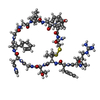+ データを開く
データを開く
- 基本情報
基本情報
| 登録情報 | データベース: PDB / ID: 3m17 | ||||||
|---|---|---|---|---|---|---|---|
| タイトル | Crystal structure of human FcRn with a monomeric peptide inhibitor | ||||||
 要素 要素 |
| ||||||
 キーワード キーワード | IMMUNE SYSTEM/INHIBITOR / IMMUNOGLOBULIN BINDING PROTEIN / Cell membrane / Disulfide bond / Glycoprotein / IgG-binding protein / Immunoglobulin domain / Membrane / Receptor / Transmembrane / Amyloid / Amyloidosis / Disease mutation / Glycation / Immune response / MHC I / Pyrrolidone carboxylic acid / Secreted / IMMUNE SYSTEM-INHIBITOR complex | ||||||
| 機能・相同性 |  機能・相同性情報 機能・相同性情報IgG immunoglobulin transcytosis in epithelial cells mediated by FcRn immunoglobulin receptor / IgG binding / beta-2-microglobulin binding / negative regulation of receptor binding / early endosome lumen / Nef mediated downregulation of MHC class I complex cell surface expression / DAP12 interactions / transferrin transport / cellular response to iron ion / Endosomal/Vacuolar pathway ...IgG immunoglobulin transcytosis in epithelial cells mediated by FcRn immunoglobulin receptor / IgG binding / beta-2-microglobulin binding / negative regulation of receptor binding / early endosome lumen / Nef mediated downregulation of MHC class I complex cell surface expression / DAP12 interactions / transferrin transport / cellular response to iron ion / Endosomal/Vacuolar pathway / Antigen Presentation: Folding, assembly and peptide loading of class I MHC / peptide antigen assembly with MHC class II protein complex / cellular response to iron(III) ion / MHC class II protein complex / negative regulation of forebrain neuron differentiation / antigen processing and presentation of exogenous protein antigen via MHC class Ib, TAP-dependent / ER to Golgi transport vesicle membrane / peptide antigen assembly with MHC class I protein complex / regulation of iron ion transport / regulation of erythrocyte differentiation / HFE-transferrin receptor complex / response to molecule of bacterial origin / MHC class I peptide loading complex / T cell mediated cytotoxicity / positive regulation of T cell cytokine production / antigen processing and presentation of endogenous peptide antigen via MHC class I / antigen processing and presentation of exogenous peptide antigen via MHC class II / positive regulation of immune response / MHC class I protein complex / positive regulation of T cell activation / peptide antigen binding / positive regulation of receptor-mediated endocytosis / negative regulation of neurogenesis / cellular response to nicotine / positive regulation of T cell mediated cytotoxicity / multicellular organismal-level iron ion homeostasis / specific granule lumen / phagocytic vesicle membrane / recycling endosome membrane / Interferon gamma signaling / Immunoregulatory interactions between a Lymphoid and a non-Lymphoid cell / negative regulation of epithelial cell proliferation / MHC class II protein complex binding / Modulation by Mtb of host immune system / late endosome membrane / sensory perception of smell / positive regulation of cellular senescence / tertiary granule lumen / DAP12 signaling / T cell differentiation in thymus / negative regulation of neuron projection development / ER-Phagosome pathway / protein refolding / early endosome membrane / protein homotetramerization / amyloid fibril formation / intracellular iron ion homeostasis / learning or memory / endosome membrane / immune response / endoplasmic reticulum lumen / Amyloid fiber formation / Golgi membrane / lysosomal membrane / external side of plasma membrane / focal adhesion / Neutrophil degranulation / SARS-CoV-2 activates/modulates innate and adaptive immune responses / structural molecule activity / endoplasmic reticulum / Golgi apparatus / protein homodimerization activity / extracellular space / extracellular exosome / extracellular region / identical protein binding / membrane / plasma membrane / cytosol 類似検索 - 分子機能 | ||||||
| 生物種 |  Homo sapiens (ヒト) Homo sapiens (ヒト) | ||||||
| 手法 |  X線回折 / X線回折 /  シンクロトロン / シンクロトロン /  分子置換 / 解像度: 2.6 Å 分子置換 / 解像度: 2.6 Å | ||||||
 データ登録者 データ登録者 | Mezo, A.R. / Sridhar, V. / Badger, J. / Sakorafas, P. / Nienaber, V. | ||||||
 引用 引用 |  ジャーナル: J.Biol.Chem. / 年: 2010 ジャーナル: J.Biol.Chem. / 年: 2010タイトル: X-ray crystal structures of monomeric and dimeric peptide inhibitors in complex with the human neonatal Fc receptor, FcRn. 著者: Mezo, A.R. / Sridhar, V. / Badger, J. / Sakorafas, P. / Nienaber, V. | ||||||
| 履歴 |
|
- 構造の表示
構造の表示
| 構造ビューア | 分子:  Molmil Molmil Jmol/JSmol Jmol/JSmol |
|---|
- ダウンロードとリンク
ダウンロードとリンク
- ダウンロード
ダウンロード
| PDBx/mmCIF形式 |  3m17.cif.gz 3m17.cif.gz | 292.3 KB | 表示 |  PDBx/mmCIF形式 PDBx/mmCIF形式 |
|---|---|---|---|---|
| PDB形式 |  pdb3m17.ent.gz pdb3m17.ent.gz | 234.5 KB | 表示 |  PDB形式 PDB形式 |
| PDBx/mmJSON形式 |  3m17.json.gz 3m17.json.gz | ツリー表示 |  PDBx/mmJSON形式 PDBx/mmJSON形式 | |
| その他 |  その他のダウンロード その他のダウンロード |
-検証レポート
| 文書・要旨 |  3m17_validation.pdf.gz 3m17_validation.pdf.gz | 509.4 KB | 表示 |  wwPDB検証レポート wwPDB検証レポート |
|---|---|---|---|---|
| 文書・詳細版 |  3m17_full_validation.pdf.gz 3m17_full_validation.pdf.gz | 525.8 KB | 表示 | |
| XML形式データ |  3m17_validation.xml.gz 3m17_validation.xml.gz | 52.6 KB | 表示 | |
| CIF形式データ |  3m17_validation.cif.gz 3m17_validation.cif.gz | 72.6 KB | 表示 | |
| アーカイブディレクトリ |  https://data.pdbj.org/pub/pdb/validation_reports/m1/3m17 https://data.pdbj.org/pub/pdb/validation_reports/m1/3m17 ftp://data.pdbj.org/pub/pdb/validation_reports/m1/3m17 ftp://data.pdbj.org/pub/pdb/validation_reports/m1/3m17 | HTTPS FTP |
-関連構造データ
- リンク
リンク
- 集合体
集合体
| 登録構造単位 | 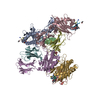
| ||||||||
|---|---|---|---|---|---|---|---|---|---|
| 1 | 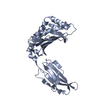
| ||||||||
| 2 | 
| ||||||||
| 3 | 
| ||||||||
| 4 | 
| ||||||||
| 5 | 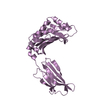
| ||||||||
| 6 | 
| ||||||||
| 7 | 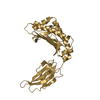
| ||||||||
| 8 | 
| ||||||||
| 9 | 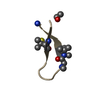
| ||||||||
| 10 | 
| ||||||||
| 11 | 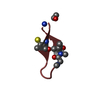
| ||||||||
| 12 | 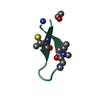
| ||||||||
| 単位格子 |
|
- 要素
要素
| #1: タンパク質 | 分子量: 29720.383 Da / 分子数: 4 / 断片: UNP residues 24-290 / 由来タイプ: 組換発現 / 由来: (組換発現)  Homo sapiens (ヒト) / 遺伝子: FCGRT, FCRN / Cell (発現宿主): CHOK1SV cells / 発現宿主: Homo sapiens (ヒト) / 遺伝子: FCGRT, FCRN / Cell (発現宿主): CHOK1SV cells / 発現宿主:  Cricetinae (ネズミ) / 参照: UniProt: P55899 Cricetinae (ネズミ) / 参照: UniProt: P55899#2: タンパク質 | 分子量: 11748.160 Da / 分子数: 4 / 断片: UNP residues 21-119 / 由来タイプ: 組換発現 / 由来: (組換発現)  Homo sapiens (ヒト) / 遺伝子: B2M, CDABP0092, HDCMA22P / Cell (発現宿主): CHOK1SV cells / 発現宿主: Homo sapiens (ヒト) / 遺伝子: B2M, CDABP0092, HDCMA22P / Cell (発現宿主): CHOK1SV cells / 発現宿主:  Cricetinae (ネズミ) / 参照: UniProt: P61769 Cricetinae (ネズミ) / 参照: UniProt: P61769#3: タンパク質・ペプチド | #4: 水 | ChemComp-HOH / | |
|---|
-実験情報
-実験
| 実験 | 手法:  X線回折 / 使用した結晶の数: 1 X線回折 / 使用した結晶の数: 1 |
|---|
- 試料調製
試料調製
| 結晶 |
| |||||||||
|---|---|---|---|---|---|---|---|---|---|---|
| 結晶化 | 温度: 277 K / 手法: 蒸気拡散法, シッティングドロップ法 / pH: 4.2 詳細: 2uL protein:peptide with 2ul solution of 100mM sodium phosphate/citric acid, 20% PEG 3350, 8% ethanol, pH 4.2, VAPOR DIFFUSION, SITTING DROP, temperature 277K |
-データ収集
| 放射光源 | 由来:  シンクロトロン / サイト: シンクロトロン / サイト:  ALS ALS  / ビームライン: 4.2.2 / 波長: 1 Å / ビームライン: 4.2.2 / 波長: 1 Å |
|---|---|
| 検出器 | 日付: 2007年9月1日 |
| 放射 | プロトコル: SINGLE WAVELENGTH / 単色(M)・ラウエ(L): M / 散乱光タイプ: x-ray |
| 放射波長 | 波長: 1 Å / 相対比: 1 |
| 反射 | 解像度: 2.6→41.1 Å / Num. all: 51434 / Num. obs: 51434 / % possible obs: 98.7 % / Observed criterion σ(F): 0 / Observed criterion σ(I): -4 |
| 反射 シェル | 解像度: 2.6→2.69 Å / % possible all: 97.8 |
- 解析
解析
| ソフトウェア |
| ||||||||||||||||||||||||||||||||||||||||||||||||||||||||||||||||||||||
|---|---|---|---|---|---|---|---|---|---|---|---|---|---|---|---|---|---|---|---|---|---|---|---|---|---|---|---|---|---|---|---|---|---|---|---|---|---|---|---|---|---|---|---|---|---|---|---|---|---|---|---|---|---|---|---|---|---|---|---|---|---|---|---|---|---|---|---|---|---|---|---|
| 精密化 | 構造決定の手法:  分子置換 分子置換開始モデル: PDB ENTRY 1EXU 解像度: 2.6→41.1 Å / Cor.coef. Fo:Fc: 0.894 / Cor.coef. Fo:Fc free: 0.827 / SU B: 15.11 / SU ML: 0.32 / 交差検証法: THROUGHOUT / ESU R: 1.51 / ESU R Free: 0.42 / 立体化学のターゲット値: MAXIMUM LIKELIHOOD
| ||||||||||||||||||||||||||||||||||||||||||||||||||||||||||||||||||||||
| 溶媒の処理 | イオンプローブ半径: 0.8 Å / 減衰半径: 0.8 Å / VDWプローブ半径: 1.2 Å / 溶媒モデル: MASK | ||||||||||||||||||||||||||||||||||||||||||||||||||||||||||||||||||||||
| 原子変位パラメータ | Biso mean: 31.112 Å2
| ||||||||||||||||||||||||||||||||||||||||||||||||||||||||||||||||||||||
| 精密化ステップ | サイクル: LAST / 解像度: 2.6→41.1 Å
| ||||||||||||||||||||||||||||||||||||||||||||||||||||||||||||||||||||||
| 拘束条件 |
| ||||||||||||||||||||||||||||||||||||||||||||||||||||||||||||||||||||||
| LS精密化 シェル | 解像度: 2.6→2.667 Å / Total num. of bins used: 20
|
 ムービー
ムービー コントローラー
コントローラー



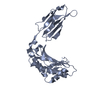

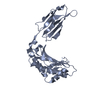
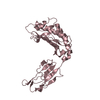
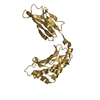
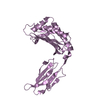
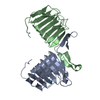
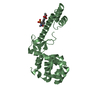
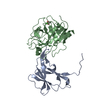
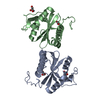
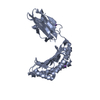

 PDBj
PDBj


